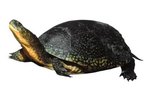Common snapping turtles (Chelydra serpentina) are found in lakes, ponds and rivers throughout the U.S. Their prevalence leads many people to keep them as pets, either in a pond or aquarium. If enough space is provided, snapping turtles can make excellent pets. However, even though snapping turtles may be hardy, their large size necessitates special environmental and dietary requirements. Many diseases can develop in captive snapping turtles if basic sanitation and dietary requirements are not maintained.
Bacterial Infections
Snapping turtles are prone to contracting bacterial infections. While most infections are the result of poor sanitation or diet, even turtles that are well cared for can fall ill from time to time. Bacterial infections affect a snapping turtle's health in many ways, from eye infections to abscesses on limbs from infected wounds. The most severe cases involve pneumonia, which can occur in two forms. Acute pneumonia can be lethal to snapping turtles in a short period of time, while chronic pneumonia is persistent over time. Both cases usually cause respiratory distress in infected turtles and will cause symptoms such as nasal discharge, gaping mouth and gasping for air. If you suspect a bacterial infection in your snapping turtle, seek veterinarian care immediately. A culture sample may be necessary before proper diagnosis. Bacterial infections are cured by antibiotics.
Metabolic Bone Disease
Metabolic bone disease is a result of poor diet and lack of proper lighting, and is identifiable by misshapen shells. Improper diet can result in malformations in the developing turtle shell that cause the rear of the shell to slope downward and the marginal scales to peel upwards. Diets that contain too little calcium and too much phosphorous as well as lack of full-spectrum lighting can lead to metabolic bone disease. Most turtles require a balanced diet and ultraviolet light in order to produce vitamin D3 and maintain healthy bones and shells. Metabolic bone disease can be treated by providing the proper diet that includes adequate amounts of calcium and protein in order to maintain healthy bone structure, as well as proper full-spectrum UV lighting to generate adequate levels of vitamin D3. Severe cases of metabolic bone disease may require additional supplementation of calcium in the form of additives to food or, in extreme cases, injections.
Vitamin Deficiencies
Vitamin deficiencies are the result of improper diet and are another common ailment of captive snapping turtles. Hypovitaminosis A and B are both the result of a diet that lacks the vitamins necessary for snapping turtles. Hypovitaminosis A can cause swollen eyes, nasal discharge, rasping noises when breathing and abscesses on their limbs. Hypovitaminosis B can result in lethargy and paralysis of the limbs. Hypovitiminosis can be treated by amending the turtle's diet with supplementary vitamins and maintaining a healthy, balanced diet once the symptoms subside. However, care should be taken not to oversaturate the diet with vitamins. Turtles are vulnerable to illness from hypervitaminosis when their diet includes too many vitamins, which can cause the turtle to slough off skin and be susceptible to bacterial infections. Carefully provide your pet snapping turtle with a proper diet and adequate environmental conditions if a vitamin deficiency is suspected. If the symptoms persist, seek veterinary advice.
Shell Rot
Shell rot is the general term used to describe lesions that infect the shell of snapping turtles. This disease can be caused by bacterial or fungal infections that are usually associated with poor water quality. Lesions develop when the shell is abraded, allowing infectious organisms to enter the wound. The infection erodes and causes decay in the bone of the turtle located under the scales of the shell. Infections can spread from the shell into the body cavity of the turtle, causing systemic infections if not treated properly. The first measure of treatment is cleaning the snapping turtle's enclosure and making sure the water remains clean. If the lesion is small, a topical application of an antibiotic or anti-fungal cream can be used as initial treatment for small infections. This cream is available at pharmacies. Keep the turtle out of water for 10 minutes after application to allow the medication to effectively penetrate the lesion. If no improvement is noticed with home treatment within a couple of days and the condition worsens, seek veterinary help.
References
- Peteducation.com: Reptiles: Common Bacterial Infections in Turtles and Tortoises: Causes, Symptoms, and Treatments
- Atlantic Coast Veterinary Conference: Turtle (Chelonian) Medicine
- Peteducation.com: Reptiles: Metabolic Bone Disease
- Anapsid.org: Chelonian Shell Infections
- Chelonia.org: Hypervitaminosis A
Photo Credits
-
Touching a Turtle image by Towards Ithaca from Fotolia.com




